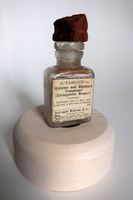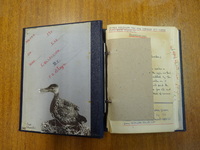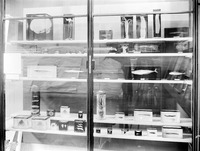Items
Site
The Medicine Chest
keywords is exactly
library
-

Livingstone
A small wooden chip from the same object collection as the medicine chest balanced on top of one of the bottles from the chest. "The treatment, the Livingstone rouser, was formulated by Dr Livingstone, who, after an attack of malaria in 1853, patented this mixture of quinine and purgatives (calomel, rhubarb and jalop) mixed with opium (Barrett & Giordani 2017: 1655–1666). The chip balanced on its lid is said to be from the almond tree under which he proposed to Mary Moffat in 1844. The juxtaposition of these two objects, one representing the quantifiable and the other the poetic, draws the viewer to consider the conflation of these two realms" (Liebenberg 2021: 273). -

Diary of an oologist
"In 2019, Honours in Curatorship student Nathalie Viruly, who completed her Bachelor of Social Science in Politics and Sociology, was similarly struck by the silence and loss evoked by the [Peter Steyn] collection. Viruly honed in on the moments documented in the notebooks, which capture the loss of life in the reproductive life of these birds and reveal ‘stories of avian tragedy’: Young taken by predator; 1 young accidentally killed; 2 eggs failed to hatch; 2 infertile; Chick disappeared without a trace; Eggs disappeared; Literally cooked by the [corrugated] roof; Nest empty – egg collectors? (Viruly 2018: online). Her focus on these moments in the scientific journal poignantly reveals the conflation between science and emotion and invites the viewer to re-examine hierarchies of loss" (Liebenberg 2021: 219). -

Terra Nova
Robert Falcon Scott’s Terra Nova expedition reached the South Pole on 17 January 1912 — 23 days too late. Inside a small tent supported by a single bamboo flying a Norwegian flag, was a record of the five who had been the first to reach the pole: Roald Amundsen, the leader, and his team - Olav Olavson Bjaaland, Hilmer Hanssen, Sverre H. Hassel and Oscar Wisting. On 19 January, they began their 1,300 kilometre journey home, Scott writing: “I’m afraid the return journey is going to be dreadfully tiring and monotonous” (Scott 1914: 548). -

Fish
A showcase of fish found in the Artic regions. -

The virus (dormant)
"When it (the chest) is not being exhibited in the Iziko South African Museum, it lives in the archives of the University of Cape Town. As part of an institution that has sworn dedication to decolonising its curriculum, it poses a somewhat latent threat. In a speech in 2015, the writer and previous vice-chancellor of the University of Cape Town, Professor Njabulo Ndebele, stated "that there can be no transformation of the curriculum, or indeed of knowledge itself, without an interrogation of archive". It is an argument which strongly suggests that a critical assessment of the archival legacy on which the institution is founded becomes of pivotal importance when developing a decolonial institution. What worth then, if any, does this dormant object serve in a new curriculum?" Extract from a paper delivered at the BSHS conference in Cambridge, 2019 -

Flood
Photo of water in Jagger Library by photographer, Lerato Maduna. On 18 April, the Jagger Library — the medicine chest's home — caught fire. The fire started on the lower sections of Rhodes Memorial at the foot of Table Mountain, and set alight landscape, monuments, and many of the university’s buildings. The library only caught fire in the late afternoon, but became a raging inferno as books, artworks, manuscripts that were worked on frequently, institutional, and administrative records of Special Collections, as well as the entire African Film collection, all went up in flames. -

Unveiling
A bronze bell with lead clapper. The artist Janine Antoni, asked about this work, stated that she "was thinking of an object that is simultaneously hiding and calling out". -

Unconquerable Spirit: George Stow and the landscapes of the San
In 2008, the exhibition 'Unconquerable Spirit: George Stow and the landscapes of the San' opened at the Iziko Museum of South Africa. Curated by Pippa Skotnes, the exhibition featured the work of a relatively unknown figure in 19th century South African history. George William Stow was a British born, South African geologist, ethnologist, poet, historian, artist, cartographer, and writer who was responsible for a creating large collection of watercolours and drawings that documented the rock art he found in the caves and shelters of South Africa. The exhibition brought together a vast range of materials representing Stow’s life and the period in which it was produced – from his drawings and paintings; his letters, documents, and poems; to his maps, and field diaries. The display shows one map in particular which is kept as part of the National Library of South Africa collections, and was drawn by Stow during the period he was conducting geological surveys of the country surrounding the diamond fields of Kimberley, down to the junction of the Orange and Vaal rivers and beyond. It shows amongst other things, the diamondiferous deposits of the Vaal river during the late 19th century and, as part of this section of the exhibition which focused on Stow the geologist, Skotnes displayed it alongside relevant disciplinary materials she sourced from the Department of Geological Sciences, University of Cape Town. -

Geological Map of the Vaal River (from 'Stow: a geological fieldguide of UCT')
"Stow’s discovery of coal deposits in 1878, found in the beds of the Vaal River, was of interest to the diamond magnate, Sammy Marks. Marks realised the importance of Stow’s discovery and the opportunity for using coal at the Kimberley diamond fields for energy generation (Leigh, 1968:112). He believed he could transport the coal from Vereeniging to Kimberley by floating it down-river by a series of weirs to his diamond claims. This turned out to be impractical and he had to resort to using ox-wagons as a method of transport instead (Leigh 1968:17). Marks & Lewis who at that time owned a quarter of all the Kimberley diamond claims, sold most of their Kimberley claims to concentrate on the coal finds through their newly formed mining company, the Zuid-Afrikaansche en Oranje Vrystaatsche Mineralen en Mijnbouvereeniging (later to become the Vereeniging Estates Limited). In 1892, the small village of Vereeniging was formally established" (Liebenberg 2021). -

Geological Map of the Vaal River
Geological Map of the Vaal River, from Fourteen Streams to the Kareyn Poort shewing the Various Formations, and the Positions of the Diamantiferous Deposits. Sheet No 11'. -

Chip of wood from an almond tree
Said to be a chip from the tree under which David Livingstone is said to have proposed to Mary Moffat 1884. Wood chip was donated by R.F. Immelman who purchased it from Kimberley museum.


